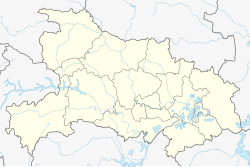
Back Tianmen German Tianmen Spanish تیانمن FA Tianmen Finnish Tianmen French Tianmen ID Tianmen Italian 天門市 Japanese Tianmen KI 톈먼시 Korean
Tianmen
天门市 Tienmen | |
|---|---|
 Tianmen South Station Entrance Hall | |
 Location of Tianmen City jurisdiction in Hubei | |
| Coordinates (Tianmen government): 30°39′50″N 113°10′01″E / 30.664°N 113.167°E | |
| country | People's Republic of China |
| Province | Hubei |
| Area | |
| 2,622 km2 (1,012 sq mi) | |
| • Urban | 324.40 km2 (125.25 sq mi) |
| Elevation | 32 m (104 ft) |
| Population (2022) | |
| 1,105,800 | |
| • Density | 420/km2 (1,100/sq mi) |
| • Urban | 301,000 |
| • Urban density | 930/km2 (2,400/sq mi) |
| GDP[2] | |
| • County-level & Sub-prefectural city | CN¥ 71.2 billion US$ 9.9 billion |
| • Per capita | CN¥ 64,707 US$ 9,010 |
| Time zone | UTC+8 (China Standard) |
| Website | 天门市人民政府门户网站 (translation: Tianmen City People's Government Web Portal) (in Simplified Chinese) |
Tianmen (simplified Chinese: 天门; traditional Chinese: 天門; pinyin: Tiānmén; lit. 'sky gate') is a sub-prefecture-level city (sometimes considered a county-level city) in central Hubei Province, China.
It is on the Jianghan Plain, on the west side of Wuhan (the biggest city of Central China, as well as the capital of Hubei) and the east of Jingzhou (a famous city in Chinese history). Formerly known as Jingling (竟陵), it was renamed to Tianmen in 1726 during the Qing dynasty. The name comes from the Sky Gate Mountains (meaning “tianmen” in Chinese) which lie northwest of the city.[3]
It is the hometown of Lu Yu, the writer of The Classic of Tea, who is respected as "the Sage of Tea" for his contribution to the tea culture. Tianmen has the largest population among the same-level cities in Central China. It was honoured "National Civilized City" by Chinese government in 2014.
- ^ a b Ministry of Housing and Urban-Rural Development, ed. (2019). China Urban Construction Statistical Yearbook 2017. Beijing: China Statistics Press. p. 66. Archived from the original on 18 June 2019. Retrieved 11 January 2020.
- ^ 天门市统计局 (April 2024). 《天门市2023年国民经济和社会发展统计公报》. Archived from the original on August 7, 2024.
- ^ Cite error: The named reference
:0was invoked but never defined (see the help page).
